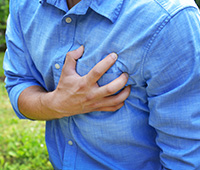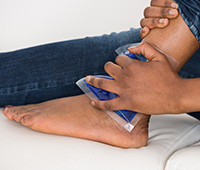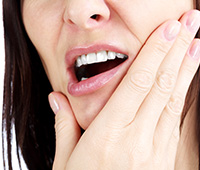WHAT IS Chest pain
- Definition
- Causes
- Symptoms
- Diagnosis
- Ayurvedic Tips
- FAQS
- References
Definition

Chest pain is any kind of discomfort or pain that you feel in your chest, i.e. anywhere along the front of your body between your neck and upper abdomen.1
Chest pain is the most common symptom of a heart attack; however, chest pain may not always cause a heart attack. There are several other causes of chest pain other than a heart attack. While some causes may not be dangerous to your health, there are other causes that could be serious and life-threatening.1There are organs and tissues in your chest apart from the heart that can be the source of chest pain. These include lungs, food pipe, muscles, ribs, or nerves. Pain may also spread to the chest from the neck, abdomen, and back, which is known as ‘referred pain’.1
Ayurveda refers to chest pain as Urah shula. Since Hridroga or heart diseases are the major cause of chest pain, Ayurveda focusses on its multiple causative factors.2
The suppression of natural urges like thirst, tears, urination, defaecation, coughing, sneezing, exertional breath etc. cause Udavarta disease (reverse movement of the Vata dosha) which itself is a causative factor for Hridroga.2 Other factors responsible for heart diseases are Abhighata (physical and mental trauma), Adhyashana (overeating), Vishmashana (irregular eating habits) etc.3
Disclaimer: The information on this page is not intended to be a substitute for professional medical advice. Do not use this information to diagnose or ayurvedic treatment of pain and/or chest pain without consulting the doctor. Consult your physician before beginning an exercise regime. "While we have products /ayurvedic medicines for pain and/or chest pain, you must consult an authorized physician before taking any of the products. For more information on products, visit www.dabur.com or call 1800-103-1644"
Causes
Causes OF Chest pain
Chest pain can be caused by numerous other medical conditions apart from an onset of heart attack. Some of these are as follows:4
- Other heart problems, such as angina (chest pain)
- Panic attacks
- Digestive problems, such as heartburn or food pipe disorders
- Sore muscles
- Lung diseases
- Inflammation of joints in your chest
Ayurveda considers physical inactivity as causative factor which is responsible for wasting of sharir dhatus (body tissues) which aggravates Vata dosha and affects an important organ like heart. Along with physical inactivity, stress also increases rate of heart beat and blood pressure, increasing the heart's need for oxygen. This need for oxygen can bring on chest pain (angina) or Urah Shula (chest pain) in people who already have heart disease. During times of stress, the nervous system releases additional hormones. These hormones increase blood pressure, which can injure the lining of the arteries leading to high blood pressure and thinning of arteries.2
Chest Pain. Summary. MedLine Plus. [Cited 2016 September 4]. Available at 2
Disclaimer: The information on this page is not intended to be a substitute for professional medical advice. Do not use this information to diagnose or ayurvedic treatment of pain and/or chest pain without consulting the doctor. Consult your physician before beginning an exercise regime. "While we have products /ayurvedic medicines for pain and/or chest pain, you must consult an authorized physician before taking any of the products. For more information on products, visit www.dabur.com or call 1800-103-1644"
Symptoms
Symptoms OF Chest pain
Some common symptoms of chest discomfort related to a heart attack or any other problem in your chest include:5
- Pressure, fullness or tightness in your chest
- Crushing or searing pain that spreads to your back, neck, jaw, shoulders and arms — particularly the left arm
- Pain that lasts more than a few minutes, aggravates with activity, goes away and comes back or varies in intensity
- Shortness of breath
- Cold sweating
- Weakness or dizziness
- Nausea or vomiting
Disclaimer: The information on this page is not intended to be a substitute for professional medical advice. Do not use this information to diagnose or ayurvedic treatment of pain and/or chest pain without consulting the doctor. Consult your physician before beginning an exercise regime. "While we have products /ayurvedic medicines for pain and/or chest pain, you must consult an authorized physician before taking any of the products. For more information on products, visit www.dabur.com or call 1800-103-1644"
Diagnosis
Diagnosis OF Chest pain
Since chest pain can indicate a life-threatening situation, doctors will first check and rule out heart attack. They may also check for life-threatening lung conditions — such as a collapsed lung or a lump in your lung.
Some of the first tests to diagnose chest pain include:
- Electrocardiogram (ECG):This test records the electrical activity of your heart through electrodes attached to your skin. Because injured heart muscle doesn't conduct electrical impulses normally, the ECG may show that a heart attack has occurred or is in progress.
- Blood tests:Your doctor may order blood tests to check for increased levels of certain proteins normally found in heart muscle. Damage to heart cells from a heart attack may allow these proteins to leak, over a period of hours, into your blood.
- Chest X-ray:An X-ray of your chest allows doctors to check the condition of your lungs and the size and shape of your heart and major blood vessels.
- Computerized tomography (CT scan):CT scans can be used to look for a blood lump in your lungs.
Disclaimer: The information on this page is not intended to be a substitute for professional medical advice. Do not use this information to diagnose or ayurvedic treatment of pain and/or chest pain without consulting the doctor. Consult your physician before beginning an exercise regime. "While we have products /ayurvedic medicines for pain and/or chest pain, you must consult an authorized physician before taking any of the products. For more information on products, visit www.dabur.com or call 1800-103-1644"
Ayurvedic Tips
Ayurvedic Tips Chest pain
Since chest pain can indicate a life-threatening situation, doctors will first check and rule out heart attack. They may also check for life-threatening lung conditions — such as a collapsed lung or a lump in your lung.
Some of the first tests to diagnose chest pain include:
- Electrocardiogram (ECG):This test records the electrical activity of your heart through electrodes attached to your skin. Because injured heart muscle doesn't conduct electrical impulses normally, the ECG may show that a heart attack has occurred or is in progress.
- Blood tests:Your doctor may order blood tests to check for increased levels of certain proteins normally found in heart muscle. Damage to heart cells from a heart attack may allow these proteins to leak, over a period of hours, into your blood.
- Chest X-ray:An X-ray of your chest allows doctors to check the condition of your lungs and the size and shape of your heart and major blood vessels.
- Computerized tomography (CT scan):CT scans can be used to look for a blood lump in your lungs.
Diet Recommendations (Aahar)
- Consume preferably vegetarian, low fat and low calorie diet, rich in whole grains, high fibre and nuts.
- Cabbage, Carrot, Green leafy vegetables, peas, tomatoes are good
- Milk and milk products, Tulsi, Amalaki fruits, Pomegranate, Apple, banana, seasonal vegetables that are good for heart.
- Fruits that are most essential for keeping the heart healthy are oranges, papaya, grapefruits.
- Use of Garlic and Onion in regular diet
Lifestyle changes (Vihar)
Exercise, yogasana and meditation helps in building a lifestyle with healthier heart through their holistic approach of balancing the doshas and lowers the stress. Beneficial yoga practices for the heart are as follows:
Pranayama (breathing exercises): Ujjayi pranayama, Dirgha pranayama and Nadishodhana pranayama
Yogasanas: Sukhasana, Tadasana, Uttanasana, Janusirasana
These Yoga practices are to be performed under medical supervision after consulting your physician.
 Sukhasana
Sukhasana Uttanasana
Uttanasana Janusirasana
Janusirasana
Disclaimer: The information on this page is not intended to be a substitute for professional medical advice. Do not use this information to diagnose or ayurvedic treatment of pain and/or chest pain without consulting the doctor. Consult your physician before beginning an exercise regime. "While we have products /ayurvedic medicines for pain and/or chest pain, you must consult an authorized physician before taking any of the products. For more information on products, visit www.dabur.com or call 1800-103-1644"
FAQS
FAQS
1. Can Ayurveda treat foot pain?
In Ayurveda, foot care is considered very important since it is known to benefit the entire body and nervous system in a holistic manner. There are certain points in our body called marma or vital points, where our vital energies are concentrated. Feet and ankles also have these vital points, which if not taken care of, can cause problems like chronic pain in the ankles, pain and swelling in feet, etc. Ayurveda can play a significant role in managing ankle pain with a combination of corrective Ahar (diet), Vihar (exercise) and Aushadhi (Medicines) regime.
2. What kind of diet and exercises will be helpful in reducing neck pain?
To reduce neck pain, Ayurveda suggests following diet and exercises:
- Take lots of fruits, green vegetable salads and sprouts.
- Good hydration will help retain neck health.
- Avoid refined foods and junk foods.
- Milk is an important source of Calcium and can help maintain healthy bones.
- Vitamin C in citrus fruits will help the healing process.
- Honey in warm water or herbal teas are good for cleansing the bowels and this will help relieve many backaches that are due to constipation.
Pranayama (breathing exercises) is a powerful way to promote relaxation and a pivotal first step towards relieving muscle tension. Slow, deep breathing & relaxation can stimulate a sense of calmness and cause reduction in pain.
Yoga Asanas are also beneficial in maintaining neck and overall health
- Balasana
- Marjaryasana
- Bhujangasana
3. I have knee pain. What could be the reasons for it?
Knee pain can have different causes. Being overweight puts you at greater risk for knee problems. Overusing your knee can trigger knee problems that cause pain. If you have a history of arthritis (swelling of knee joint), it could also cause knee pain.
Medical conditions that can cause knee pain are
- Arthritis – Rheumatoid arthritis, Osteoarthritis, Gout
- Infection in the knees / knee joint
- Injuries – fracture, dislocation, sprained knees etc.
- Cancer
4. What can I do to reduce my knee pain?
Ayurveda suggests following diet and lifestyle changes to help reduce knee pain.
Include more foods containing
- Pulses: Black gram, green gram
- Vegetables & spices: Onion, garlic, sesame seeds, ginger, radish, ladies finger, pumpkin
- Fruits: pomegranate, mango, grapes
- Oils: Ghee
Ayurveda recommends regular, slow and gentle exercises with adequate rest to knee joints. Regular Pranayama and Yoga Nidra is also recommended.
- Avoid prolonged walking, standing, kneeling and squatting and crossed leg sitting.
- Yoga asanas: Makarasana, Pavanamuktasana, Dhanurasana, Vakrasana
5. I have tingling pain in the legs. Is it sciatica?
Sciatic pain most often occurs on one side of leg or hip. Symptoms of sciatica pain can vary widely as mentioned below:
- Mild tingling
- Dull aching that radiates from buttock to back of whole leg
- Burning sensation
- Inability to move leg when pain becomes severe
The pain often starts slowly and may get worse:
- After standing or sitting
- At night
- When sneezing, coughing, or laughing
6. What diet is effective in reducing the sciatica pain?
A healthy diet for controlling sciatica pain is for balancing Vata dosha and includes:
- Grains: Rice, cooked oatmeal, whole wheat and whole grain breads (toasted)
- Pulses: Yellow split mung beans (green skin removed), whole mung beans, red lentils and tofu
- Vegetables: : Zucchini, asparagus, carrot, beets, sweet potatoes, cucumber, lady finger, parsley, green peas, fennel, spinach in small amounts and cooked coconut. All should be cooked well so they are soft.
- Spices: Cumin, ginger, mustard seeds, ajwain, celery seeds, fenugreek, coriander, bay leaves, basil, saffron, hing (asafoetida), cinnamon, cardamom, cloves, anise, fennel, black pepper (in small amounts)
- Fruits: All ripe, sweet, and juicy fruits. Sweet grapes, banana, melons, plums, cherries, mango, papaya, pomegranate, sweet pineapples, raisins, sweet oranges, dates and figs, avocado, apples and pears.
- Oils: Ghee or organic olive oil
- Sweeteners: Honey, jaggery, date sugar
7. I frequently get gas pain. What food types are good for me?
Following foods are good to help relieve gas pain:
- Grains: Whole wheat thick flat bread or chapati, millet & sorghum bhakri, unpolished rice
- Pulses: Chickpea, Tur dal, Masoor Moong
- Vegetables: Carrots, Radish, Lauki, potatoes, white gourd, spiny gourd, , cucumber, ajwain, guar bean, eggplant, amaranth, cabbage, spinach, coriander seeds and leaves, sweet potatoes, tomatoes, green chillies, lady finger
- Fruits: , pears, papaya, pineapple, pomegranate, oranges, unripe bananas, water chestnut, dry fruits – almonds, walnuts, peanuts, dry dates, apples, grapes etc.
- Oils: Ghee, coconut oil in small quantities
- Ginger, cumin, coriander should be preffered in spices.
8. What is trigeminal neuralgia?
Trigeminal nerve (TN) pain is a nerve condition that causes a stabbing or electric-shock-like pain in parts of the face.
It usually affects one side of the face. Any vibration on your face, even from talking, brushing etc. can set it off. The condition may come and go, disappearing for days or even months. But the longer you have it, the less often it goes away. TN pain usually affects women and people above 50 years of age.
Ayurveda describes 11 types of shiro rogas (headaches), among which trigeminal nerve type of pain is called ‘Ardhavabhedaka’. It happens when aggravated doshas (Vata, Pitta and Kapha) press on the neck and throat producing a powerful burning sensation, out of which comes excruciating pain. This pain ultimately affects the eyes, eyebrows and temples.
9. How can Ayurveda help in relieving stomach pain?
Ayurveda describes a comprehensive approach towards managing stomach pain- the most commonly diagnosed conditions being constipation (Vibandha) and indigestion (Ajirna)
Constipation is used to indicate fewer bowel movements, hard stools, painful defection and feeling of bloating, abdominal pain or incomplete elimination.
Indigestion, on the other hand, is an abnormality that occurs in digesting food or lack of proper digestion resulting in stomach pain, burping or flatulance (abdominal gas).
Ayurveda can play a significant role in managing & preventing different stomach pains by practising a combination of corrective Ahar (diet), Vihar (exercise) and Aushadhi (Medicines) regime
Corrective Ahar for both constipation & indigestion includes:
Grains: Wheat, unpolished rice, barley
- Pulses: Green gram, chickpeas, course corn, Toor dal, moong, masura lentils, Vegetables/Spices: Garlic, Asafetida, long pepper, sunthi (dry ginger), green leafy vegetables, cucumber, bitter gourd, pointed gourd, cabbage, dates, betel nut, turmeric
- Fruits: High fibre fruits such as apples, pears, papaya, grapes, amala, haritaki
- Oils: Ghee
Exercise: Regular exercise, meditation and practice of asanas purifies the blood, improves the appetite, increases the will power and makes the patient physically active. The whole alimentary canal improves and becomes regular.
Yoga Asanas: Vajrasana (after every meal), Kurmasana, Vakrasana, Katichakrasana
Pranayama: Surya anulom viloma, deep relaxation technique
10. What is myofasial pain?
Myofascial pain disorder (MPS) refers to pain and swelling in the body's soft tissues or muscles. Myofascial pain is a long-term, painful condition that affects the connective tissue that cover the muscles. It is considered as a type of muscular pain (fibromyalgia) which happens at specific areas on the body.
Myofascial pain might involve either a single muscle or an entire muscle group. In some cases, the area where you experience the pain might not be where the myofascial pain is generated. The actual location of the injury leads to the development of a trigger point, which in turn causes pain in other areas. This is known as referred pain
Disclaimer: The information on this page is not intended to be a substitute for professional medical advice. Do not use this information to diagnose or ayurvedic treatment of pain and/or chest pain without consulting the doctor. Consult your physician before beginning an exercise regime. "While we have products /ayurvedic medicines for pain and/or chest pain, you must consult an authorized physician before taking any of the products. For more information on products, visit www.dabur.com or call 1800-103-1644"
References
References
Chest Pain. MedLine Plus. 2014. [Cited 2016 September 4]. Available at: https://medlineplus.gov/ency/article/003079.htm
2. Patil DB. AN AYURVEDIC REVIEW OF CARDIOVASCULAR DISEASES. IJAAR VOLUME 1 ISSUE 9 JAN-FEB 2015.55-65
3. Soni Anamika & Soni Surendra. CARDIAC DISEASES AND AYURVEDA: A REVIEW. IAMJ: Volume 3; Issue 1; January – 2015. 73-78
4. Chest Pain. Summary. MedLine Plus. [Cited 2016 September 4]. Available at: https://medlineplus.gov/chestpain.html
5. Ayurvedic approach to some selected diseases. Central Council for Research in Ayurveda and Siddha. Government of India. 2009
6. Nilanjana D. Diet In Elderly: An Ayurvedic Perspective. Scholars Journal of Applied Medical Sciences. 2014;2(2B):660-3.
7. Boolani H, Reddy N, Atkins D, Lakkireddy D. Healing the Heart: Can Yoga be the Missing Piece that Completes the Puzzle in Modern Medicine?. Journal of Yoga & Physical Therapy. 2013 Dec 12;2013.
Disclaimer: The information on this page is not intended to be a substitute for professional medical advice. Do not use this information to diagnose or ayurvedic treatment of pain and/or chest pain without consulting the doctor. Consult your physician before beginning an exercise regime. "While we have products /ayurvedic medicines for pain and/or chest pain, you must consult an authorized physician before taking any of the products. For more information on products, visit www.dabur.com or call 1800-103-1644"



